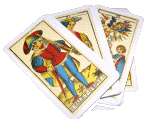
Bohemian Gothic Tarot
THREE OF PENTACLES
Lighter or more conventional meanings
A master craftsperson * Being recognised for your achievements * Attaining a high level of skill * Producing a masterpiece * Reaching the peak of artisanship in your chosen craft or skill .
Darker, shadow or more hidden meanings
Putting your own need to achieve above all other considerations * Refusing to take responsibility for what you produce * A lack of ethics in your work * A desire for fame and recognition that leads to a callous and uncaring attitude.This is the card of the master craftsman, and of anyone who has attained eminence in their own field, particularly where this involves manual or artisan skills. In our card, we see Viktor Frankenstein, brilliant though misguided research doctor and surgeon, who has succeeded in piecing together a new man from human remains. In this scene his creation has just come to life; still wrapped in bandages he staggers across the room, confused and devoid off all memories or understanding of who or what he is. Dr. Frankenstein looks on in delight, oblivious to the creature's distress.
This card is generally read as symbolising mastery and achievement in a fairly straightforward way. The RWS card shows two people, probably patrons, admiring the work done by a stone-mason, and so it carries also an indication of recognition for work that's well done. In the Bohemian Gothic picture, it's the maker himself - Dr. Frankenstein - who seems to be congratulating himself on his achievement. We can surmise that he is thinking only of himself, and the prospect he has of amazing the world with his ability to make life. He sees his creature in terms of the fame it will bring him, not as a bewildered person who needs reassurance and explanation of who he is and how he came into being.
We can interpret this card as a warning that we must take responsibility for what we produce, whether this is a scientific break-through, a piece of polemical or political writing, or merely a simple thing such as a plant that we've grown from seed or an animal that we've bred. Similarly, it can indicate a tendency to put your own work and recognition before all other considerations, including those of friends and family. To be a master in what you do - whether it be a manual, musical or artistic skill - is a wonderful achievement, but the Three of Pentacles reminds us that at the same time, the more emotional and caring aspects of life should not be forgotten.
Some further ways to consider this card
There are some similarities between this image and that on the Eight of Pentacles, which also shows a man gazing after his creation - in that case a doll that could be possessed or animated in some way. Compare the cards and consider what different aspects of artisanship and creation you associate with them.It was on a dreary night of November that I beheld the accomplishment of my toils. With an anxiety that almost amounted to agony, I collected the instruments of life around me, that I might infuse a spark of being into the lifeless thing that lay at my feet. It was already one in the morning; the rain pattered dismally against the panes, and my candle was nearly burnt out, when, by the glimmer of the halfextinguished light, I saw the dull yellow eye of the creature open; it breathed hard, and a convulsive motion agitated its limbs.
- Mary Shelley Frankenstein.
THE GOLEM OR ARTIFICIAL MAN
The notion of an inanimate doll or figure brought to life seems to run deep in myths and traditional tales. At its most light-hearted there are characters in children's stories like the Gingerbread Man, who comes to life just as he is brought, fully cooked, out of the oven. More threateningly, there are tales of objects that come to life and can't be controlled, such as the brooms in Goethe's The Sorcerer's Apprentice. There are, too, dolls that are inhabited by the spirits of the dead such as the doll that protects and advises "Beautiful Vassilisa" , in the traditional Russian tale. This idea has been most notoriously and successfully (in commercial terms anyway) developed in the Child's Play, series of films, which centre on a murderous possessed doll called Chucky.In Judaism, there are early stories of golems; animated figures made of mud which, though alive and in a sense wondrous, were considered a mere shadow of a real human being made by God. The most famous of these is the golem that Rabi Loew is believed to have created to protect the Jewish ghetto in Prague in the early 17th century - which ended up running rampant in the city. But the myth has gradually evolved; a golem used to be believed to be the result of a holy person's God-given power to create life, but it steadily came to be seen as a much more sinister monster. In the 1920 Paul Weggener's German Expressionist horror film, Der Golem, wie er in die Welt kam (the Golem: How He Came Into the World) the creature is murderous and threatens an entire community. While in Gustav Meyrink's nightmarish Der Golem (1915), the main character seems to be gradually possessed by the Prague golem's gloomy spirit.
Though there have been periodic appearances of the golem in film - most notably perhaps in Herbert Leder's 1967 It, the ancient figure of the golem never became particularly popular in the 20th century Gothic genre. Instead, the character that has captured the popular imagination is the rather more spectacular and gruesome monster created from human body parts by Dr. Frankenstein, in Mary Shelley's Frankenstein, or The Modern Prometheus (1818). Remarkably, Shelley was only nineteen years old (and still the unmarried Mary Godwin) when she wrote the book. At the time she and her then love, Percy Bysshe Shelley, were staying with Lord Byron in his house, "Villa Diodati" by Lake Geneva. It was during the notorious "year without a summer" and, unable to go out much, the party amused themselves instead by writing horror stories. As I've mentioned elsewhere in this book, the result was two Gothic classics, Polidori's Vampyre and Shelley's tale of Doctor Frankenstein ("Frankenstein" is, by the way, the name of the doctor, his Monstrous creation is not named in the book). The novel quickly spawned a number of stage plays, both serious and humorous, and it seems to have been these, more than the actual novel, on which later films were based. The most famous of these was the 1931 version which starred Boris Karloff. This became the definitive depiction of the creature. Throughout the 20th century the theme of Frankenstein continued to be wildly popular in film and dozens of versions were made, including the unforgettably-titled. Abbot and Costello Meet Frankenstein (Charles Barton 1948), Jesse James Meets Frankenstein's Daughter (William Beaudine 1966) Dracula, Prisoner of Frankenstein (Jess Franco, 1972) and Mel Brooks' popular parody, Young Frankenstein (1974). However, the figure has never acquired the romantic and darkly sexual reputation of the vampire, probably simply because ugliness and ungainliness is one of his inescapable characteristics. It seems as if artificial creatures made of flesh or mud may be fascinating, but will never be either elegant or stylish and we are unlikely ever to see hordes of Goth teenagers dressing up as golems or as Frankenstein's monster - which is probably just as well.









